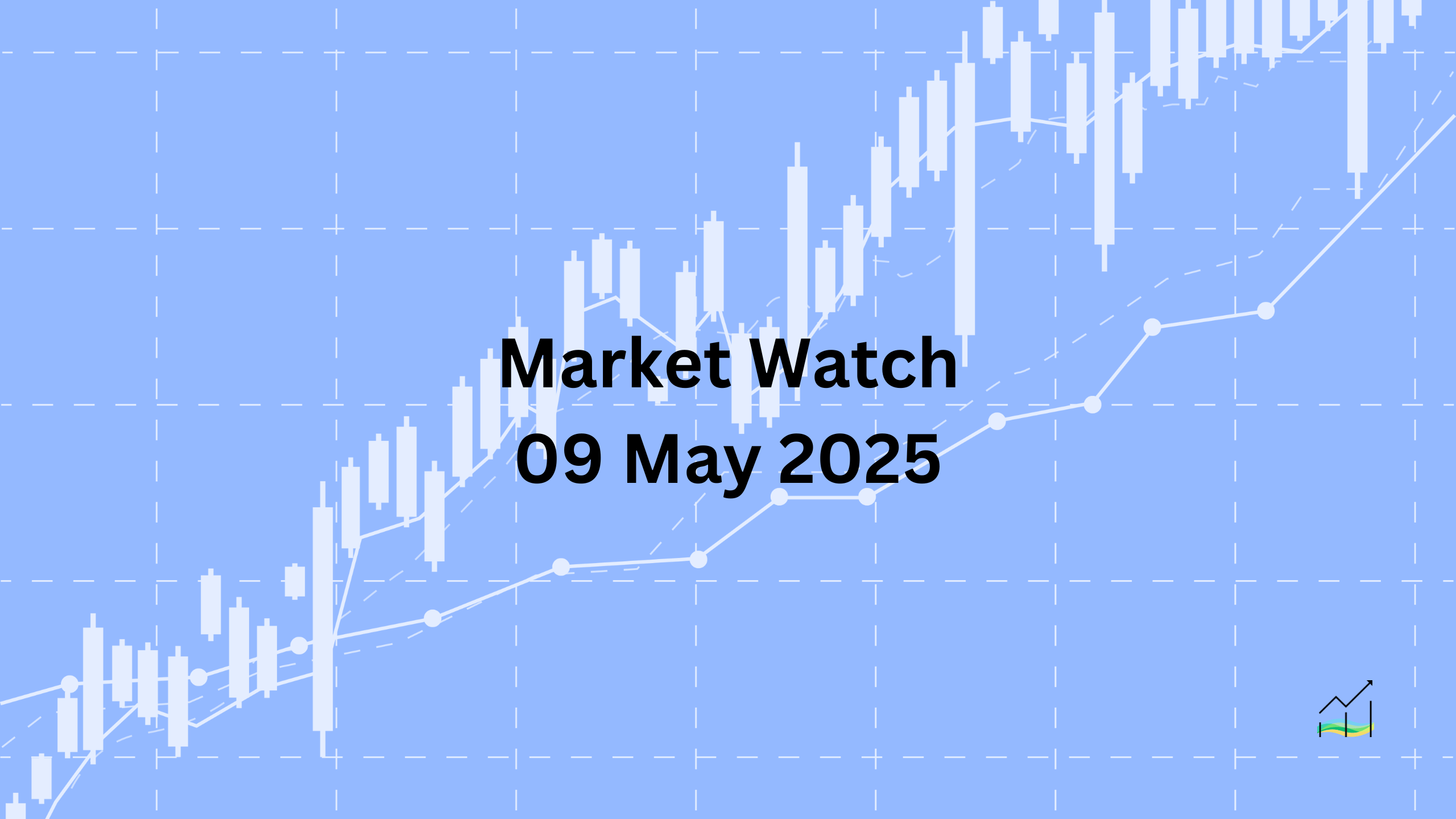09/05/2025 Market Watch

Markets Recalibrate Ahead of US-China Trade Talks as Dollar Retreats
Key Takeaways:
- The US dollar reversed its gains and is now weaker against most G10 and emerging market currencies.
- China’s exports rose in April despite a sharp drop in US-bound shipments.
- Market focus is on upcoming US-China trade talks, with little hope for meaningful tariff relief.
- Equities are mixed globally; Asia is divided, Europe is modestly higher, and US futures are steady.
- Yields are broadly higher across major economies following a sharp Treasury sell-off.
- Gold has stabilised after a volatile week, and crude oil has rebounded above key technical levels.
The US dollar's brief recovery was short-lived as it turned lower today, giving back much of yesterday’s gains against both G10 and emerging market currencies. East Asian currencies, which had previously strengthened, are now facing their third consecutive day of losses. Attention is squarely on tomorrow’s trade discussions between the US and China. Although expectations remain low, the talks could influence future trade dynamics. Despite ongoing tensions, China managed to offset the decline in US-bound exports with gains elsewhere, pushing total exports higher in April. The challenge now lies with the US — can it swiftly replace Chinese supply? So far, logistics data suggests the transition won’t be immediate.
Market sentiment remains cautious but resilient. In Asia, equity markets showed mixed performance, with China under pressure while Japan, Taiwan, and New Zealand each gained over 1%. European markets opened firm, with the Stoxx 600 looking to end the week in positive territory. US futures are holding steady after yesterday’s strong rally.
Bond markets are still digesting yesterday’s heavy Treasury sell-off. Yields continued climbing across major regions — Japan and Antipodean 10-year rates are up 4-5 basis points, while Europe saw a 4-6 basis point rise. The US 10-year yield remains relatively stable near 4.37%. Meanwhile, commodities are showing signs of stabilisation: gold has regained footing after a two-day plunge and crude oil has climbed back above its 20-day moving average, fully recovering from Monday’s decline.
United States of America
Overview
The US Dollar Index briefly reached its highest level in nearly four weeks at 100.85 before retreating to 100.35 during early European trading, where it found some stability. A close below 100.00 would likely disappoint dollar bulls, but the overall bias remains cautious. Despite a flurry of Federal Reserve speakers today, the session lacks any scheduled economic data, and expectations for a June rate cut remain muted. Market focus is now shifting to next week's inflation data, where both headline and core CPI are expected to show stability rather than any sharp disinflationary progress.
Geopolitical focus is also intensifying, particularly with US-China trade talks scheduled over the weekend. Despite low expectations, hopes remain for at least a partial de-escalation, though the current tariff structure is still viewed as highly restrictive. Even a halving of these duties would maintain severe trade limitations. In parallel, the US is also pushing trade talks with Japan, although a resolution is unlikely before next month. Japan is seeking a comprehensive discussion on all tariffs, while the US appears narrowly focused on so-called “reciprocal tariffs.” The implementation of delayed US tariffs may coincide with Japan’s upper house elections in July, adding further political complexity. China, on the other hand, insists on a broad agreement that respects its core demands, but US officials continue to downplay China’s negotiating position — a risky underestimation that could backfire diplomatically.
Economic Drivers
- Fed speakers dominate today's agenda, but markets do not expect any shift in tone to support a near-term rate cut.
- Attention is shifting to next week’s CPI data, expected to show steady inflation trends.
- US-China trade talks this weekend carry geopolitical weight, with low expectations for meaningful resolution.
- Fast-tracked US-Japan trade talks face friction over scope; Japan demands full tariff discussions while the US prefers selective terms.
- Political timing may influence trade decisions, particularly in light of Japan’s upcoming July elections.
Data and Events
- May 9, 2025: Multiple Federal Reserve officials scheduled to speak.
Price Action
- The Dollar Index briefly touched 100.85 before pulling back to 100.35; key support remains near the 100.00 mark.
- Further upside is limited unless new macroeconomic data or Fed commentary shifts market expectations.
- The index is struggling to build on recent momentum, reflecting investor caution ahead of CPI and trade updates.
Key Points:
- The Dollar Index failed to hold early gains and is now consolidating near 100.35.
- Market attention is turning to next week’s CPI data for inflation guidance.
- Nine Fed speakers today are unlikely to shift expectations for June policy.
- US-China and US-Japan trade dynamics remain tense and politically charged.
- The risk of underestimating China's stance could create diplomatic missteps.
China
Overview
The Chinese yuan weakened further as the dollar extended its recovery, briefly touching CNH7.2530. The next resistance level is seen near CNH7.26, ahead of the CNH7.30 psychological threshold. For the second straight session, the People’s Bank of China set a higher daily reference rate, suggesting a degree of tolerance for a weaker yuan. This shift may reflect China’s strategic posture amid evolving global trade dynamics and a stronger US dollar backdrop.
Despite a steep 21% drop in exports to the US in April, China managed to grow its overall exports by 8.1%, driven by stronger shipments to India, Southeast Asia, and the European Union. Imports also reflected a similar divergence — while inbound trade from the US declined by nearly 14%, total imports fell only 2%. These figures underscore China’s ability to diversify its trade partners and reduce reliance on US demand, at least in the short term. Market participants now await April’s CPI and PPI reports due over the weekend, which are expected to show ongoing consumer price weakness and deeper producer price deflation.
Economic Drivers
- The PBOC has allowed a modest weakening of the yuan, as seen in the higher daily fixings.
- China’s trade data highlights successful export redirection away from the US to alternative markets.
- A significant contraction in imports from the US signals ongoing geopolitical and economic decoupling.
- Focus is on inflation data, with deflationary pressures still apparent in both consumer and producer prices.
Data and Events
- May 10, 2025: April Consumer Price Index (CPI).
- May 10, 2025: April Producer Price Index (PPI).
Price Action
- USD/CNH rose to nearly CNH7.2530, with resistance seen around CNH7.26.
- The yuan weakened after two consecutive higher fixings from the PBOC.
- Market attention is on whether CNH7.30 will be tested if pressure persists.
Key Points:
- The yuan continued to weaken as the dollar advanced, nearing CNH7.26 resistance.
- The PBOC’s higher fixings suggest tolerance for further yuan depreciation.
- China’s exports rose overall despite a sharp drop to the US.
- CPI and PPI figures due this weekend are expected to confirm persistent deflationary trends.
Japan
Overview
The Japanese yen weakened as the dollar closed near JPY145.90 — its strongest level in nearly a month — before slipping back toward JPY145.00. Although initial attempts to breach higher resistance around JPY146.20 failed, the broader dollar trend remains firm unless a decisive break below JPY145 occurs. Technically, a key trendline from the January and March highs stands near JPY147, which could be tested if bullish momentum resumes.
On the macro front, Japan’s labour market showed signs of slowing. Nominal labour cash earnings increased by 2.1% in March, down from 2.7% in February, while real earnings — adjusted for inflation — declined by 2.1% year-over-year, matching the decline seen in March 2023. However, consumer resilience was evident as household spending rebounded by 2.1% in real terms year-over-year, a sharp recovery from the 0.5% contraction recorded in February. This improvement suggests a modest pickup in private consumption heading into Q2. Looking ahead, Japan is set to release its preliminary Q1 GDP figures next week. Market consensus expects a slight contraction of 0.1%, driven by weak net exports, though inventory accumulation and consumer spending may offer some support.
Economic Drivers
- Slower nominal wage growth and persistently negative real earnings reflect weak income dynamics.
- Real household spending surged by 2.1% year-over-year, suggesting improving consumer sentiment.
- Private consumption appears to be stabilising after a flat Q4 2024 performance.
- Expectations for Q1 GDP point to a slight contraction due to weak external demand and moderate inventory gains.
Data and Events
- May 9, 2025: March Labour Cash Earnings.
- May 9, 2025: March Household Spending.
- May 16, 2025: Preliminary Q1 2025 Gross Domestic Product (GDP).
Price Action
- USD/JPY reached JPY145.90 before retreating to JPY145.00.
- Resistance remains near JPY146.20, with a broader trendline around JPY147.
- A close below JPY145 would weaken bullish momentum in the near term.
Key Points:
- The yen weakened as the dollar briefly reached its highest level in nearly a month.
- Wage growth slowed while real earnings remained negative for the third consecutive March.
- Household spending beat expectations with a 2.1% year-over-year increase.
- Preliminary Q1 GDP is expected to show a mild contraction, dragged by weak exports.
United Kingdom
Overview
Sterling came under renewed pressure yesterday, briefly dipping to around $1.3210 before staging a modest recovery above $1.3270. Market sentiment remains cautious, with traders eyeing whether the currency can sustain a close above $1.3260 to signal a broader consolidation phase. The sharp move followed the Bank of England’s widely anticipated decision to reduce its base rate by 25 basis points to 4.25%. While the cut itself was expected, markets interpreted the overall message as a sign that the BoE is likely to proceed cautiously with further easing.
Looking forward, markets are pricing in a slower pace of rate cuts, expecting the policy rate to fall to around 3.64% by year-end — only marginally below the current 4.25%. This is a slightly firmer stance than what was priced in last week when expectations were closer to 3.53%. The near-term outlook will be shaped by next week’s release of labour market data and Q1 GDP figures. The UK economy is believed to have expanded by approximately 0.3% in the first quarter, signalling a tentative recovery after near-stagnation in the second half of 2024.
Economic Drivers
- Bank of England cut the base rate by 25bps to 4.25%, as expected.
- The central bank signalled a gradual approach to easing, reducing expectations for aggressive cuts.
- Market-implied year-end rate is now 3.64%, slightly higher than the 3.53% seen last week.
- Preliminary estimates suggest the UK economy grew by 0.3% in Q1 2025, following weak performance in H2 2024.
Data and Events
- May 9, 2025: BOE Gov Bailey Speaks.
Price Action
- GBP/USD fell to $1.3210 before recovering past $1.3270.
- A close above $1.3260 suggests potential for consolidation in the short term.
- Downward pressure remains unless supported by strong data next week.
Key Points:
- Sterling weakened following the BoE’s quarter-point rate cut.
- Markets expect only gradual easing from the central bank going forward.
- Attention now shifts to upcoming jobs data and GDP for Q1 2025.
- A modest economic rebound is expected after a sluggish second half of 2024.
© 2025 SKONE Enterprise (003319453-V). All rights reserved.
The content on this site is for informational purposes only and does not constitute financial advice.


